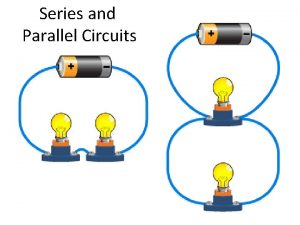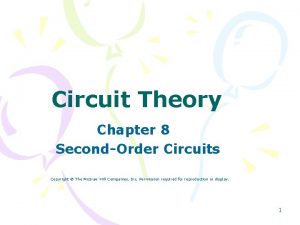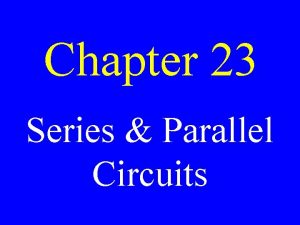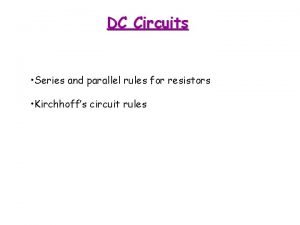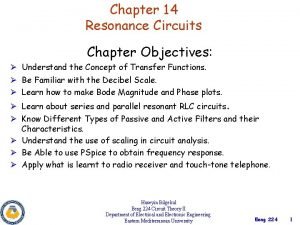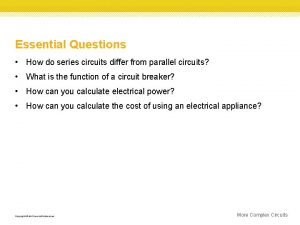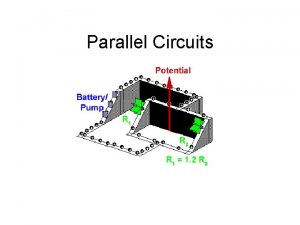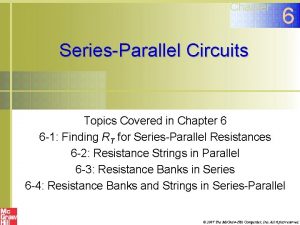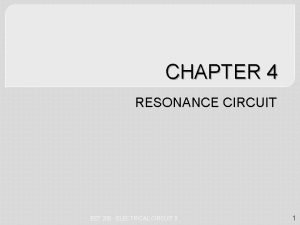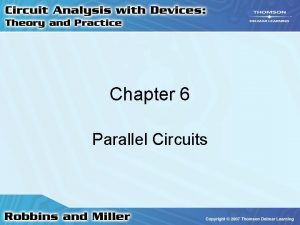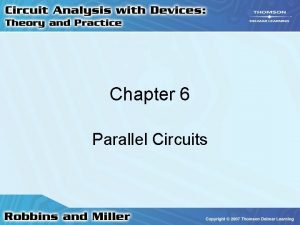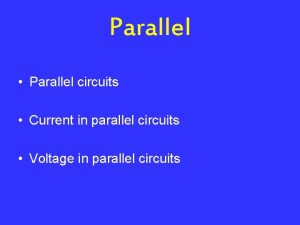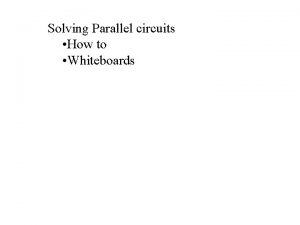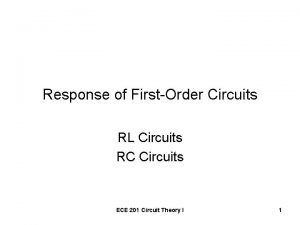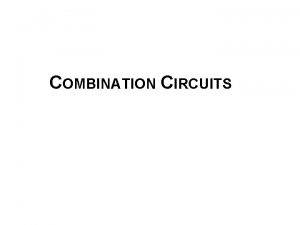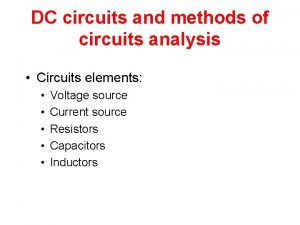Parallel Circuits Parallel Circuits n In parallel circuits






















- Slides: 22

Parallel Circuits

Parallel Circuits n In parallel circuits the current can take more than one path. n We call these separate paths branches. n The branch points are known as Junctions

Voltage and parallel circuits n In parallel circuits, every branch gets the full voltage that the battery puts out 12 V 6 V 6 V n Different from series – where the voltage is distributed depending on resistance.

This doesn’t mean every object gets full voltage, just that every branch carries the full voltage. Objects on the branch still distribute the voltage. 6 V 12 V 6 V

Kirchhoff’s Current Law – The “Junction Rule” n The total current entering a junction point must be equal the total current of the branches leaving the junction point. If the current entering the junction I 1 is 5 Amps, then I 2 and I 3 must total to equal 5 Amps

If I 1 is 8 Amps and I 2 is 5 Amps, What is I 3 ? If i 1 is 8 A, i 3 is 6 Amps, and i 4 is 12 A then what is i 4?

Parallel Circuits function differently n The separate branches alter how voltage is distributed, current flows, as well as how effective the total resistance is in parallel vs series circuit. n Ohm’s Law applies for both series and parallel circuits:

Resistance in parallel circuits If done by hand, requires the use of common denominators to find total R If plugged into a calculator, it does that step for you.

Calculating resistance in parallel circuits A circuit contains a 2 -ohm resistor and a 4 ohm resistor in parallel. Calculate the total resistance of the circuit.

Calculating resistance in parallel circuits A circuit contains a 2 -ohm resistor and a 4 ohm resistor in parallel. Calculate the total resistance of the circuit.

Comparing Resistances

Find the total resistance for each circuit if the resistance of each lamp is 8 Ohms. .

With parallel circuits, many objects can be turned on and off without stopping the current to the whole circuit.

Voltage and parallel circuits Parallel circuits have threes advantages over series circuits: n 1. Each branch in the circuit has a voltage drop equal to the full battery voltage. 2. Because total resistance is lower in parallel, it lets a higher current flow (since I = V/R) 3. Each device in the circuit may be turned off independently without stopping the current in the other devices in the circuit using a switch.

Calculating current and resistance Calculate the total resistance, total current, and current in each branch for the circuit shown.

Calculating current and resistance Calculate the total resistance, total current, and current in each branch for the circuit shown. 1. Use the formula for parallel resistance and Ohm’s law. 2. Solution: part 1 1/Rtot = 1/5 + 1/1 = 1/5 + 5/5 1/Rtot = 6/5 Rtot = 5/6 = 0. 83

Calculating current and resistance Calculate the total resistance, total current, and current in each branch for the circuit shown. I = V/R Itot = (3 V)/(0. 83 ) = 3. 6 A I 1 = (3 V) ÷ (1 ) = 3. 0 A I 5 = (3 V) ÷ (5 ) = 0. 6 A

Find current through branch D

Find total R and total Current

Find the Current through each branch, and then the total current

Parallel vs. Series n Remember: series/same/current; parallel/same/voltage. n Use Ohm’s law for both.

Important review
 Advantages of parallel circuit over series circuit
Advantages of parallel circuit over series circuit Facts about series circuits
Facts about series circuits Series circuit vs parallel circuit
Series circuit vs parallel circuit Lesson 8: comparing series and parallel rlc circuits
Lesson 8: comparing series and parallel rlc circuits Chapter 23 series and parallel circuits answers
Chapter 23 series and parallel circuits answers Series circuit rules
Series circuit rules Bill nye series and parallel circuits
Bill nye series and parallel circuits Difference between series and parallel circuits
Difference between series and parallel circuits Pros and cons of parallel circuits
Pros and cons of parallel circuits Series and parallel circuits
Series and parallel circuits Venn diagram series and parallel circuits
Venn diagram series and parallel circuits How do series and parallel circuits differ
How do series and parallel circuits differ Types of parallel circuits
Types of parallel circuits Solving parallel circuits
Solving parallel circuits Lesson 8 comparing series and parallel rlc circuits
Lesson 8 comparing series and parallel rlc circuits Every circuit must have
Every circuit must have Parallel circuit characteristics
Parallel circuit characteristics Contiusly
Contiusly Parallelism rules
Parallelism rules Parrelell structure
Parrelell structure Parallel structure purdue owl
Parallel structure purdue owl Two like parallel forces
Two like parallel forces Mary likes hiking swimming and to ride a bicycle
Mary likes hiking swimming and to ride a bicycle

